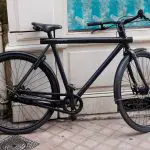There isn’t a better time to switch to an electric bike than now. The good news is there are electric bike conversion kits, which can be great tools to turn your average push pedal bike into an efficient bike with more power. You don’t have to purchase a new bike, and you’ll save a lot of money.
Electric bicycle conversion kits first came out a long time ago, but they are only gaining popularity because more people are aware of climate change. These bikes are an excellent way for people to adjust their lifestyles and contribute to a greener environment.
E-bike kits are quite easy to install on many traditional bikes, and they are also affordable. Furthermore, they come with a wide range of benefits. For instance, you can boost your bicycle with extra power when you’re going uphill and reuse some of that energy for your everyday cycling.
There are loads of electric bike conversion kits that work in different ways. This guide will examine various types of kits, how to install them, and their benefits.
Which Electric Bike Conversion Kit Should I Purchase?
To choose the right kit, you need to familiarize yourself with all the types of motors available.
Direct Drive vs. Geared Hub Motors
Direct Drive Hub Motors
These are the most straightforward form of e-bike propulsion, although they are bigger and heavier than their geared counterparts. Direct drive hub motors demand more energy to pick up speed. But after they get going, they build on that momentum along the way, which helps them reach maximum speed.
Direct-drive hub motors have two major parts: a stator and a rotor. The bike’s hub remains stationary in the stator, and the wheel rim rotates around it in the rotor. Its simple design includes the wheel hub as the axis and the wheel rim as the outer casing.
Once the bike receives electricity from the rechargeable battery through the axle, it creates an electromagnetic field. The magnets installed around the wheel rim react to this by rotating to move the bike forward.
The advantage of direct-drive hub motors is that they don’t make much noise compared to conventional bicycles. Their motor is noiseless because the magnets and copper hub do not touch each other. Additionally, the motor has no gears rubbing together, so there is minimal noise produced.
However, direct-drive hub motors are not as efficient. They have substantial weight and require higher initial energy to speed up. As a result, their batteries don’t last long compared to those of geared motors.
Geared Motors
As the name suggests, this type has gears rotating inside the motor, instead of magnets or brushes. Geared hub motors are smaller in size, so they are often inconspicuous. The compact design makes the bicycle appear less modified.
The motors connect to a stator, built into the planetary rotation gear. When the wheel receives energy, the motor turns the gears quickly, propelling the wheel.
The benefit of using geared motors is that each rotation occurs faster than in direct-drive motors, so there is optimal energy efficiency. The system works at a more efficient speed while producing enough torque for riding varying terrains, including hills.
On the flipside, geared motor kits are small in size, so they cannot continually build speed as direct drives can. They also have lower top speeds and a shorter lifespan.
Front Hub Motor vs. Rear Hub Motor
Front-Wheel E-Bike Conversion Kit
The best option for a front-wheel electric conversion is a small, geared hub motor because it is compact, lightweight and produces a lot of torque. It is the most accessible design to install.
You will want to install front-wheel hub motors :
- There is enough space between the forks. If the wheel is narrower than the fork, you can use packing washers to make it fit. If the electric motor is wider than the dropouts, it might not be possible to fit. Another option is to spread the fork, which might work, but it might pose some challenges if you do it incorrectly. The design of the front fork should also allow the motor to spin freely with some clearance.
- The width of the front fork dropouts allows the axle to slide without major sideways movement. There needs to be enough depth in the dropouts.
- There is space to fit the battery. This spacing makes the design of the bike look better and improves your riding experience.
Rear Hub Motors
You will need to fit rear hub motors when there is sufficient space between the dropouts. The motor also needs a compatible sprocket.
All-In-One Wheel Kits
All-in-one electric bike wheels are becoming increasingly popular. They give you the ability to easily turn your standard bike to an electric one by merely replacing the wheel. The wheel houses all the e-bike components – motor, controller, battery, and sensors.
These wheel kits are a fantastic and cleaner way to add an electric assist to the bike because you won’t see all the components of the e-bike.
Installing Electric Bike Conversion Kits
A new mid-drive electric bike costs a couple thousand dollars. On the other hand, a DIY mid-drive costs almost half the amount, including the remodelled bike’s cost. This difference shows that you can make significant savings when converting a decent bike to electric assist.
The bike you are converting to electric needs to meet some standards. First, you need to examine the bicycle to find out whether it is in a working condition. Check whether the brakes function, and whether riding it is comfortable. Any problems present in the bike will become amplified when the conversion happens due to the extra power coming from the bike.
The bicycle also needs to have a sound suspension system in place to endure higher pressure. You might also need to add a rear carriage, which can hold extra batteries when the conversion occurs.
Steps for converting your bike into an electric one:
Put the batteries in place. You will need to know what voltage battery the bike requires. Usually, 24 or 36 volts are typical, and you can source them from a range of cost-effective batteries. For instance, you can place the UPS batteries with 12 volts in a series connection to produce the required voltage.
- After connecting the batteries, connect the motor and throttle to the controller. Attach the motor to the frame of the bike using clamps then fix the throttle on the handle. Attach the wires from the throttle to the controller and make sure they are correctly tied to prevent them from falling off.
- Test the bike by placing it upside down and pressing the throttle. You should be ready for a few hiccups that might require rewiring. Keep adjusting and readjusting as you test the bike to achieve a full-fledged ride.
Tips When Converting Your Conventional Bike to an E-Bike
Follow these tips for a smoother conversion process:
Think of How Much Weight the Kit Will Add
Kits range from about 8 to 20 pounds. Cumbersome kits could push the load on the bike over the recommended limit for that bike.
You should also consider how much weight is going into specific areas of the bike. In other words, you should pay attention to the placement of the battery. For instance, a battery attached to the handlebar is not ideal because it can affect bike handling.
The battery should be in a central region of the bike as low as possible. You could install it on the downtube of the bicycle, if possible.
Ensure the Kit Is Legal
It is possible to build an electric bike that doesn’t conform to the definition of road-legal machines. Fitting the wrong kit might produce an illegal e-bike. In the US, state laws determine the legality of e-bikes. Most states are adopting the three-class model for electric bikes.
The three-class models state that e-bikes are the same as conventional bicycles regarding road use. The law stipulates that assisted speed should be about 20mph with the fitted kit and produce a power output of 750W. For road lanes, use pedelec where you peddle for the power to kick in, or throttle.
The third class is the pedelec, which is only up to 28mph and 750 watts. The third-class options sometimes have restrictions for use, limited to bicycle and pedestrian routes.
Most European counties adhere to the 15.5 mph maximum assist speed at the 250W power limit.
Ensure the Kit Isn’t Easy to Modify
If you have an accident, you risk getting into trouble with the authorities if they closely scrutinize your bike. Additionally, a hub motor will not be running at its most efficient range if you have it geared for a faster speed but restricted to a lower one. This discrepancy adversely affects its battery range and overall performance.
Look at the Kit Manufacturer’s Track Record
It is crucial to look at how long the manufacturer has been in business. Also, research what independent, third-party reviews say about them. How comprehensive is the information they provide about their product?
The manufacturer should have an excellent track record and positive reviews showing that its product provides sustainability and compatibility to many bikes. You should also look at what warranty the manufacturer is providing. More extended warranties are a sign that the company has amassed a long history of customer satisfaction.
Look at the Wiring Run
The wiring runs originating from the motor to the battery and other system components should be long enough. You should check the wires before purchasing the kit.
Bear in mind that you will require extra wiring run for some operations. For instance, other safety systems may require you to replace brake levels that need extra wires.
Benefits of DIY Conversion of Your Bike to Electric
- You keep your current bike – If you cherish your non-electric machine and don’t want to replace it, you can upgrade it to an e-bike.
- Uniqueness – The type of bike you like may not be available in an electric version. You can use an electric bike conversion kit to customize your preferred type of bicycle.
- Greener – If you already own a bike, modifying it to electric is a greener option. You don’t need a new bike to replace the one you already have.
- Swapping kits – You can swap kits between bikes, which grants you the option to try electric-assist on different bicycles. Also, because it is easy to remove the front hub wheel kit, you can use the bike unassisted whenever you like by merely swapping the wheel back and leaving off the battery. You can also choose to electrify multiple bikes and fully use the battery by swapping it between bikes.
- Lightweight – With kits, it’s possible to put together a very lightweight electric bike. Some bikes can be as light as 22 pounds and even lighter with a higher budget.
- Great value for money – Kits are affordable, especially if you have a donor bike at your backyard or garage. You can have it converted quite affordably to a new electric bike.
- Tinkering – Those who enjoy fiddling with bikes may become fascinated by the endless variations of motor kits and bikes. The performance of a kit partly depends on the bicycle. Hub motors usually are suitable for a specific wheel size to maintain a given speed limit. However, it is possible to change the design characteristics of e-bikes. For instance, if you fit a hub motor designed for a larger wheel to a smaller one, it will give more pulling power at lower speeds, which produces a great load-hauler or hill climber.
Final Thoughts
E-bikes are the future of transportation in the world. They are fancy, efficient, and help achieve green energy targets. With an electric bike conversion kit, you can join the movement toward sustainable transportation – and save money while you do it!
We hope this guide will help you convert your bike to an electric one with much ease. If you’ve enjoyed reading this article, continue reading our blog to acquire more information.





